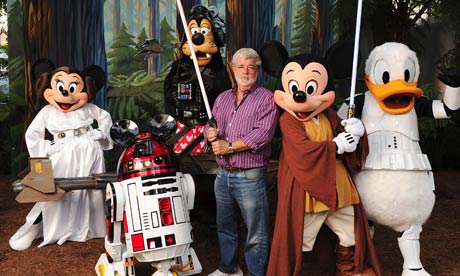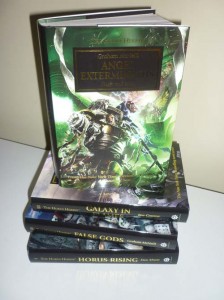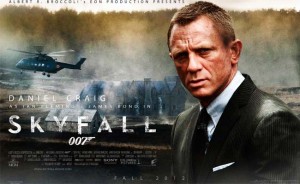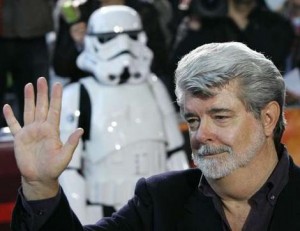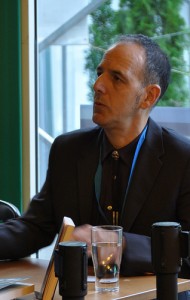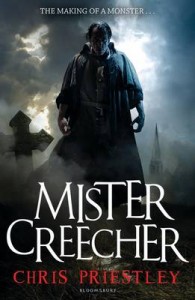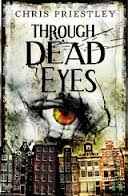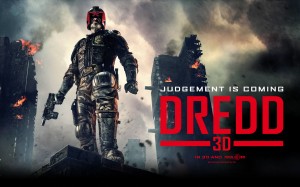
Under Judgement: The Case of Dredd 3D vs. Judge Dredd
Pitting the recent Dredd 3D against the 90s flop Judge Dredd seems unfair, like allowing an F-22 Raptor to go into battle against a Sopwith Camel. One is a high-tech, modern creation with generations of technological development over its rival. The other is made up of cheap canvas and Stallone’s wooden acting. Both operate on the same basic premise: following nuclear war, the east coast of America is dominated by a vast mega-city, rife with crime and policed by militant kill-teams of Judges. And that’s about where the similarities end. The old film was a box-office and critical bomb, the recent film a solid success across the board.
It would be easy to write off the older film as a product of Hollywood’s early infatuation with graphic fiction, an unheeded portent of the horrific Batman and Robin yet to come. Certainly John Wagner, co-creator of the original Judge Dredd in the 2000 AD comics, wrote it off as ‘nothing to do with Judge Dredd’. I’m not here to argue with the creator – Judge Dredd is a bad, bad film and not even a Lawgiver pressed to my head will convince me otherwise – but comparing the two films side-by-side hints at some of the failings of the new Dredd 3D, as well as the squandered potential of the original. So, with that being said, court is now in session.
The Plaintiffs – Urban and Stallone’s Dredds
Dredd 3D sold itself to the fans on one promise: Karl Urban would never remove his helmet. The fact that Stallone spent more time out of his helmet than in it was one of the many nails in the coffin of the original, and entirely missed the point of Dredd as a character. Simply put, he isn’t actually a character, but rather follows Batman in being a symbol. In this case, Dredd is the living avatar of law: uncompromising, absolute, ruthless. Karl Urban captures that down to Dredd’s trademark perma-scowl, and his superiority to Stallone’s portrayal is no more evident than in the iconic ‘I am the Law’ line. Stallone’s was staccato and yelled, with the ham dial turned all the way up to eleven, while Urban’s is low and growled, reminiscent of Dirty Harry that so influenced the original character. Stallone sounded like he was trying to convince people he was the law; with Urban, the line is a warning.
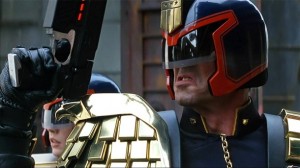
Stallone as Dredd
Stallone’s failing was that his Dredd was too human. A lot of this had to do with clichés forced into the story that stuck out from the original setting like a sore thumb – the contrived and under-developed romantic sub-plot between Dredd and another judge being the chief culprit. But a second contributing factor was the plot of Judge Dredd itself, and the failed aspirations it possessed.
The plot of Dredd 3D is simple, and a cynic may compare it to the hugely successful Indonesian action flick The Raid: Redemption. Two Judges, Dredd and a dewy-eyed rookie, become trapped in a vast habitation-block and must destroy the drug-producing, and drugged-up, gang that controls it in order to escape. A simple excuse for brutal action scenes and moments of dark humour, but little else. Judge Dredd, on the other hand, had far greater aspirations: a rogue Judge takes over the justice system and frames Dredd to remove him as a threat to sundry nefarious plans.
I’m going to reiterate my belief that Judge Dredd was a bad film right now so my next comment isn’t misread. On paper, Judge Dredd’s plot is far more interesting than that of Dredd 3D. The latter certainly has a sense that the hyper-violence, heavy-ordinance action of the film is just another day in the office for Dredd, but bears little importance. Judge Dredd was not only larger in scope, but in meaning as well: Dredd runs afoul of the system he embodies. As unwavering as the law itself, he is forced to confront the fact that he has been falsely convicted. The law has made a mistake. This could (again, emphasis on the could) have made for a plot with far greater personal significance, in a style similar to the 2000 AD comics A Letter to Judge Dredd, Tales of the Dead Man and Wilderlands.
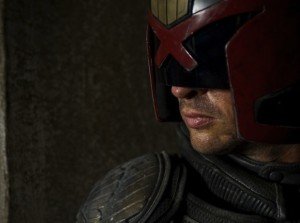
Karl Urban as Dredd. A better choice?
Those involved in Judge Dredd misinterpreted this as an opportunity to humanise Dredd, leading to the limp and bawling portrayal that Stallone gives – little more than a man whose faith has been shaken and feels lost without the certainty the law provides. If they’d really understood the Dredd from 2000 AD, we might have ended up with a defiant, still-unswerving Dredd going up against the corrupted system. The spirit of the law fighting the letter of the law. But if wishes had wheels, I’d be a wagon.
As things stand, Urban delivers a more enjoyable, and more accurate, portrayal of the character, but said portrayal is wasted on Dredd 3D’s plot. Pitting Urban’s Dredd against a tower crawling with goons is the perfect example of using a sledgehammer to crack a walnut. Successful, no doubt about that, but capable of so much more.
The Witnesses – Supporting Cast
If we’re being kind about Judge Dredd, we might say that it’s a very ‘busy’ film. If we’re being honest, ‘a mess of secondary characters’ might be more fitting. The film is, in a word, crowded; so much so that the only neat way to represent the hoard of plot-relevant participants is goddamn bullet points. So we have:
- The idealistic Judge who falls for Dredd.
- The villain with an axe to grind against the justice system.
- The corrupt Judge hungry for power who joins forces with the villain and, spoilers, is betrayed.
- Dredd’s noble, elderly mentor who has ‘kill at the end of the second act for dramatic gravitas’ written all over him.
- Rob Schneider being Rob Schneider.
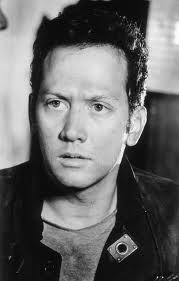
Rob Schneider, stunned
Now I know I just praised Judge Dredd for its grand ambitions, so it seems hypocritical to slam it for its oversaturation of characters. But while the original comics certainly had a broad cast to help shoulder its larger stories, they also had a far greater opportunity to focus and develop each individual character. Judge Dredd, on the other hand, with only an hour and a half run-time (which somehow manages to feel longer than it is), simply doesn’t have the narrative focus to develop any of these background characters beyond cue-card descriptors. The audience is barely even given the essential ‘why?’ of these characters: the villain is vengeful and manic because he is, Dredd’s love interest falls for him because she does, Rob Schneider is in this film… Actually, ‘why?’ is a very good question for that.
In short, Judge Dredd tried to run before it learned to walk, and it ended up stumbling over its own legs, leading to the chaotic, shallow mess we wince at today.
Dredd 3D makes far more confident steps, but isn’t entirely free of the occasional wobble. Its secondary character roster is only two members long, with sufficient depth of personality in each to warrant their actual naming. Anderson is a rookie Judge-to-be under final assessment by Dredd. As an orphan from the slums of the mega-city, her idealistic streak and desire to help rather than just punish is actually given a solid foundation, while the fact that she possesses telepathy thanks to radioactive mutation (as an aside: it’s nice to see radiation doing awesome things to comic characters again) actually gives her some genuine moments of depth: the genetic outsider with a tough core beneath her aspiring, naïve and vulnerable exterior.
However, Anderson’s character does stumble at points. The running sub-plot of her development is her being confronted by the horrific realities of being a Judge, and the human cost of grieving families left behind after the execution of even the vilest gang thugs. The problem is that this development seems to be put on hold for every action scene: in one moment she’ll be locked in a moral quandary over her actions, in the next mowing down a room of minions with an assault rifle, and then back to her quandary in the third. Now, anyone that’s ever played a D&D game I’ve run will attest to my belief that the rule of cool trumps everything, but on the other hand, if you’re aspiring to make your action-story character more (no pun intended) three dimensional, then even I’m expecting consistent characterisation.
By contrast, Ma-Ma, the villain of Dredd 3D and matriarch of the habitation-block’s gang, is a truly excellent character, and it’s all down to her portrayal by Lena Headey. Seriously, between this, Sarah Connor and Cersei Lannister, Headey is cornering the market in portraying utterly ruthless women with a layer of emotional scars hidden just beneath the surface. Her actions in Dredd 3D are standard villain fare: executing incompetent henchmen, throwing wrenches in the heroes’ plans, plotting the takeover of the city. But the sheer force of the acting Headey puts into it turns what would otherwise have been a forgettable character into possibly my favourite villain of the year. With her, you get the feeling that Ma-Ma, after suffering years of abuse and manipulation as a prostitute, is finally getting her revenge on the world by doing to it what it has done to her, and when another male forces his way into her life to dictate matters, she fights with all the brutality a once-oppressed, now-freed slave can muster.
The Scene of the Crime – Action and Visuals
When your setting’s premise is an overpopulated, crime-ridden city built in the aftermath of a nuclear apocalypse, you expect the resulting film to be, well… in a word: violent.
Judge Dredd was guilty of the worst action film crime: the misguided belief that all an action scene requires to be exciting and enjoyable is one man spraying a room with bullets (others spraying bullets back at said man optional). For a film about a highly trained, brilliantly equipped group of future warriors that make SWAT look like the neighbourhood watch, Judge Dredd’s action was disappointingly lacklustre. A lot of bright flashes, loud bangs and people falling over one another in their death throes, but never an adrenaline-pumping sense of danger, visceral thrill of violence or gut-tightening feeling of tension. Even the climactic confrontation between Dredd and his poorly established nemesis falls into the cliché of ‘I punch you then you punch me’ that even Final Fantasy has evolved beyond.
The same uninspired, rehashed and disengaging banality informs Judge Dredd’s visuals. Mega-City One, rather than appearing as one of humanity’s last desperate bastions isolated in a nuclear wasteland, teetering on the bring of chaos, is a dark, towering monstrosity informed in equal parts by Blade Runner and Akira, but lacking the impact and brilliance of either. There is no sense of scale or place – we might as well be looking at a futuristic Gotham, or whatever fever dream The Fifth Element takes place in.
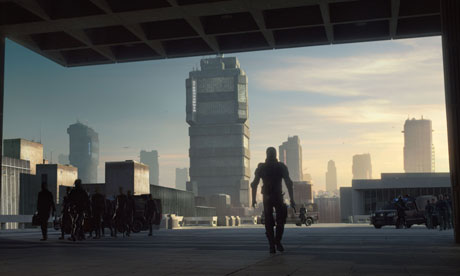
Mega-City One in Dredd 3D
By contrast, even if Dredd 3D is unambitious in its plot, it certainly doesn’t disappoint on the action scenes such a plot delivers. The movie is the epitome of video-game logic: the characters must literally ascend a series of levels, fighting through increasingly challenging scenarios before encountering ‘the boss’. But, like any well-constructed video-game, each scenario offers something new to the mix to keep the audience hooked. The almost effortless and casual police brutality at the beginning gives way to a tense game of cat and mouse as, outnumbered and running low on ammo, the Judges are trapped in a hostile environment. Brutal hand-to-hand combat, scenes of righteous vengeance, mind games and betrayal – Dredd 3D delivers something new with each action scene, and it hits all the right spots every time. Special mention has to be made of the accompanying music: the best electronic sound-track since Tron: Legacy, blending harsh industrial for the combat and hallucinatory melodies for the drug-induced slow-motion scenes (whoever thought up the idea of a drug that causes people to perceive the world in slow-motion should be given a medal).
Similarly, Dredd 3D gets Mega-City One right. Sprawling, crowded, sun-bleached and constantly in decay and disrepair, evoking contemporary images of Chinese tenements and South American slums that simultaneously capture the general scale of the setting, but also the individual hardship and tragedy of life. It even manages to get in a few nods (admittedly right at the start) to the satirical themes of the original Dredd comics with a modern twist: unmanned drones, communication surveillance and collateral damage being the big three that sprung to my mind.
Final Verdict
Like the Raptor and Camel, pitting these two films together can only lead to one outcome. Dredd 3D is hands down the better film: better acted, better written and an all-around better experience. But still, I can’t shake the feeling after watching it that it could have done so much more. Judge Dredd tried to do something interesting with the setting, characters and concepts. It failed miserably, but like the Sopwith Camel it made an effort to go somewhere new and barely-explored. Dredd 3D, like the Raptor, is a perfection of its class that will (if there’s any justice in Holywood) come to dominate its chosen theatre of war for a long time to come. This is the standard popcorn action-fests should be measured against. But it lacks innovation and ambition: the plot played it safe, more a means to an end than an end in itself.
Still, a lack of ambition is not a crime in any statute I am aware of. Dredd 3D has gone a long way towards bringing a fringe property back into the mainstream after the infamous sins of its predecessor. In the autumnal hinterlands between summer and Christmas blockbusters, the real crime would be missing out on this film while it’s still in theatres.
Griff Williams, writer
Editor’s note: Griff is the latest addition to the geekzine team, a NGOTB (New Geek On The Block), if you please. Why don’t you see just how talented this chap is and check out Griff’s excellent website, www.griffwilliams.com
